-
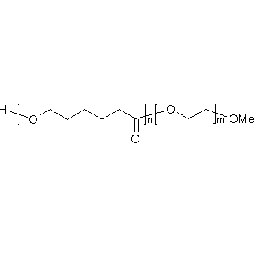 PCL(1,000)-b-PEG(1,000), Diblock PolymerCatalog Number 25010
PCL(1,000)-b-PEG(1,000), Diblock PolymerCatalog Number 25010Caprolactone itself is a biodegradable polyester with a relatively low melting point (60C) but a glass transition temperature (Tg) around -60C. The high crystallinity in the polyester accounts for this property balance. It is made by metal catalyzed ring opening polymerization of epsilon caprolactone. A typical molecular weight of standard polycaprolactone homopolymer is 188k Daltons. By comparison, a 100% polylactic acid homopolymer with Mw 330k Daltons has a (Tg) temperature of +55C and a melting temperature, Tm of about 175C.
-
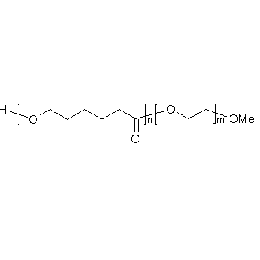 PCL(1,000)-b-PEG(5,000), Diblock PolymerCatalog Number 25012
PCL(1,000)-b-PEG(5,000), Diblock PolymerCatalog Number 25012Caprolactone itself is a biodegradable polyester with a relatively low melting point (60C) but a glass transition temperature (Tg) around -60C. The high crystallinity in the polyester accounts for this property balance. It is made by metal catalyzed ring opening polymerization of epsilon caprolactone. A typical molecular weight of standard polycaprolactone homopolymer is 188k Daltons. By comparison, a 100% polylactic acid homopolymer with Mw 330k Daltons has a (Tg) temperature of +55C and a melting temperature, Tm of about 175C.
-
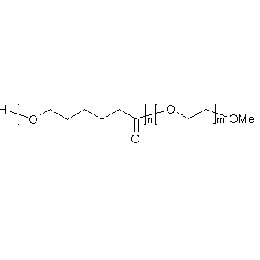 PCL(5,000)-b-PEG(1,000), Diblock PolymerCatalog Number 25022
PCL(5,000)-b-PEG(1,000), Diblock PolymerCatalog Number 25022There is increased interest in biodegradable polymers for both biomedical and industrial applications. Among the leading candidates for biodegradation are caprolactone based materials due to it's approved uses by the FDA for drug delivery systems, sutures, long term implants and adhesion barriers as well as new tissue scaffold host systems.
-
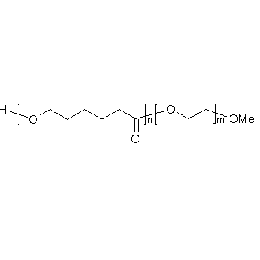 PCL(5,000)-b-PEG(2,000), Diblock PolymerCatalog Number 25023
PCL(5,000)-b-PEG(2,000), Diblock PolymerCatalog Number 25023Caprolactone itself is a biodegradable polyester with a relatively low melting point (60C) but a glass transition temperature (Tg) around -60C. The high crystallinity in the polyester accounts for this property balance. It is made by metal catalyzed ring opening polymerization of epsilon caprolactone. A typical molecular weight of standard polycaprolactone homopolymer is 188k Daltons. By comparison, a 100% polylactic acid homopolymer with Mw 330k Daltons has a (Tg) temperature of +55C and a melting temperature, Tm of about 175C.
-
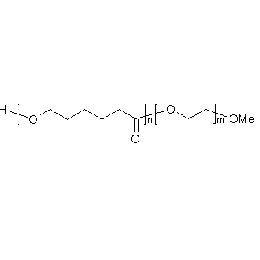 PCL(5,000)-b-PEG(5,000), Diblock PolymerCatalog Number 25024
PCL(5,000)-b-PEG(5,000), Diblock PolymerCatalog Number 25024Caprolactone itself is a biodegradable polyester with a relatively low melting point (60C) but a glass transition temperature (Tg) around -60C. The high crystallinity in the polyester accounts for this property balance. It is made by metal catalyzed ring opening polymerization of epsilon caprolactone. A typical molecular weight of standard polycaprolactone homopolymer is 188k Daltons. By comparison, a 100% polylactic acid homopolymer with Mw 330k Daltons has a (Tg) temperature of +55C and a melting temperature, Tm of about 175C.
-
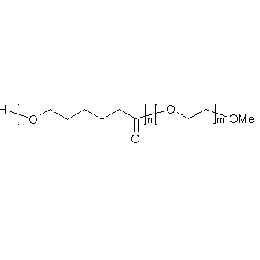 PCL(1,000)-b-PEG(2,000), Diblock PolymerCatalog Number 25011
PCL(1,000)-b-PEG(2,000), Diblock PolymerCatalog Number 25011Caprolactone itself is a biodegradable polyester with a relatively low melting point (60C) but a glass transition temperature (Tg) around -60C. The high crystallinity in the polyester accounts for this property balance. It is made by metal catalyzed ring opening polymerization of epsilon caprolactone. A typical molecular weight of standard polycaprolactone homopolymer is 188k Daltons. By comparison, a 100% polylactic acid homopolymer with Mw 330k Daltons has a (Tg) temperature of +55C and a melting temperature, Tm of about 175C.
Polycaprolactone & Polyethylene Glycol Diblock Polymers
